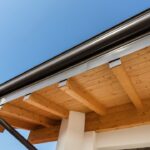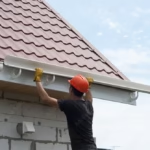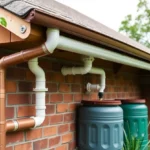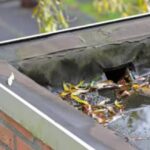When it comes to maintaining a home, especially one with a sloped roof, ensuring effective drainage is crucial. Proper roof drainage prevents water accumulation, which can lead to leaks, structural damage, and even mold growth. In this article, we will explore essential roof drainage tips for sloped roofs to help homeowners protect their investments.

Understanding Sloped Roof Drainage
Sloped roofs are designed to allow water to flow downward and off the roof efficiently. However, without a proper drainage system, water can accumulate, causing potential damage. It’s important to understand how roof drainage systems work and what components are involved.
Components of a Roof Drainage System
- Gutters: These are channels that collect water from the roof and direct it away from the home’s foundation.
- Downspouts: These vertical pipes carry water from the gutters down to the ground level.
- Roof Flashing: A material placed around roof features, such as vents and chimneys, to prevent water from seeping in.
The Importance of Regular Maintenance
Regular maintenance is key to preventing issues with roof drainage systems. Leaves, debris, and dirt can clog gutters and downspouts, impeding water flow. Regular cleaning ensures that water can flow freely, reducing the risk of roof damage.
Essential Tips for Effective Roof Drainage
1. Install Quality Gutters and Downspouts
Investing in high-quality gutters and downspouts is essential for effective roof drainage. Ensure they are properly installed to handle the volume of water from your roof, particularly during heavy rainfalls.
2. Regularly Inspect and Clean Gutters
Regularly inspect your gutters for clogs and damage. Clean them at least twice a year, or more often if you have overhanging trees. This prevents water from overflowing and causing damage to the roof and walls.
3. Ensure Proper Slope of Gutters
Ensure that your gutters have the correct slope to allow water to flow towards the downspouts. A general rule is a quarter-inch slope for every 10 feet of gutter.
4. Install Gutter Guards
Consider installing gutter guards to prevent leaves and debris from clogging the gutters. These guards help reduce maintenance and ensure consistent water flow.
5. Inspect Roof Flashing
Check the flashing around roof penetrations to ensure they are intact. Damaged flashing can lead to leaks and water damage.
6. Trim Overhanging Branches
Trim any overhanging tree branches to prevent leaves and debris from falling onto the roof and into the gutters. This simple step can significantly reduce gutter clogs.
Common Roof Drainage Problems
Poorly Installed Gutters
Poorly installed or undersized gutters can lead to water overflow and potential damage to the home’s foundation. Ensure they are properly sized and installed by a professional.
Ice Dams in Winter
In colder climates, ice dams can form on sloped roofs, blocking water flow and causing leaks. Ensuring proper insulation and ventilation can help prevent this issue.
Blocked Downspouts
Blocked downspouts can cause water to back up and overflow from the gutters. Regularly check and clear any obstructions to maintain effective drainage.
Conclusion
Effective roof drainage is crucial for maintaining the integrity of your home. By implementing these roof drainage tips for sloped roofs, homeowners can ensure proper water flow, prevent damage, and protect their investment. Remember, regular maintenance and inspections are key to a healthy roof.

FAQs
Q1: How often should I clean my gutters?
A1: It is recommended to clean your gutters at least twice a year, ideally in spring and fall. However, if you have many trees around your home, more frequent cleaning may be necessary.
Q2: What is the best way to prevent ice dams?
A2: The best way to prevent ice dams is by ensuring your attic is well-insulated and ventilated. This helps maintain a consistent roof temperature and prevents snow from melting and refreezing at the eaves.
Q3: Can I install gutter guards myself?
A3: Yes, gutter guards can be installed as a DIY project. However, for the best results and to ensure proper installation, you may want to hire a professional.
For more detailed information on roof drainage solutions, visit roof drainage solutions for residential buildings. Additionally, you can learn about roof drainage systems for various types of roofs.
This article contains affiliate links. We may earn a commission at no extra cost to you.







